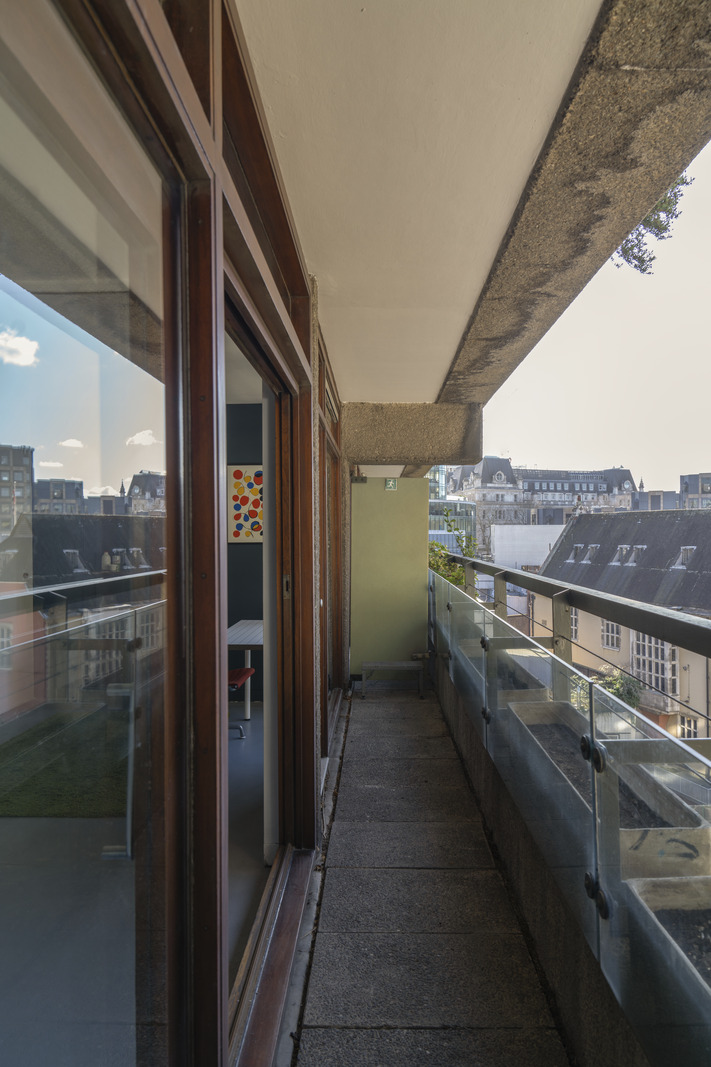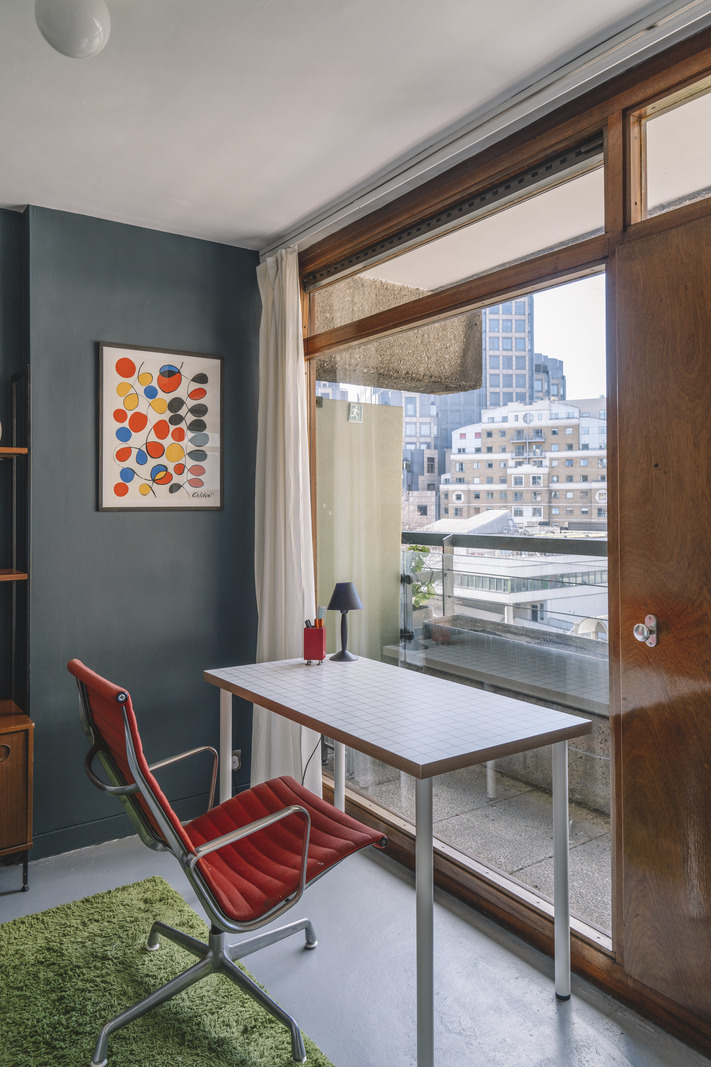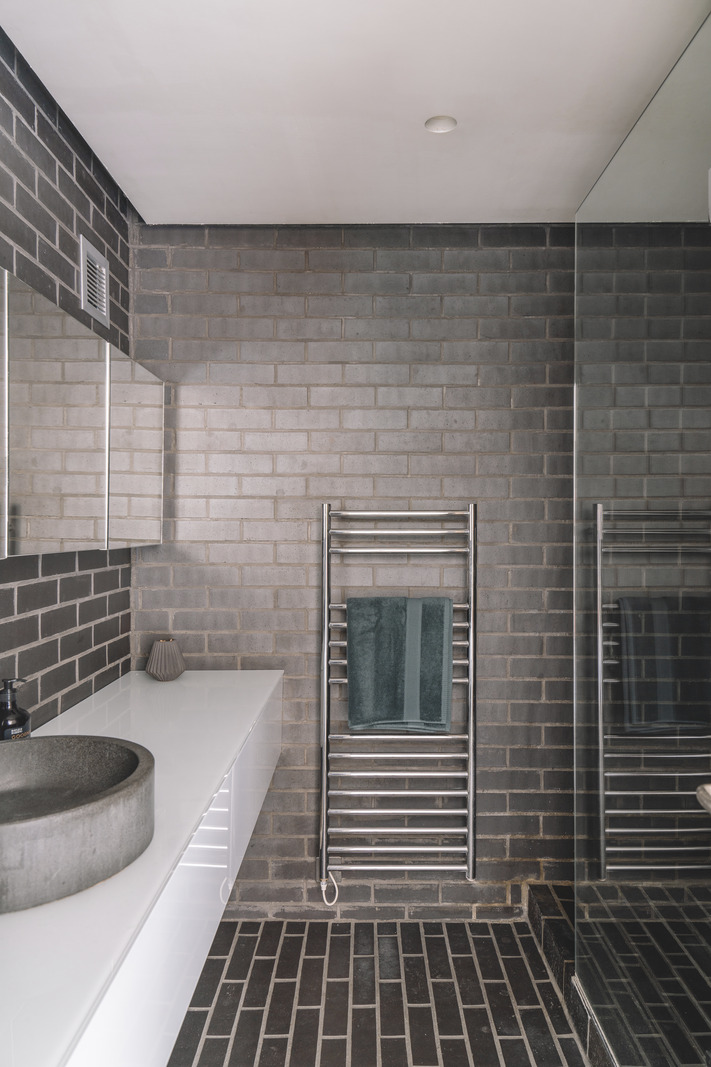
























Mountjoy House
Barbican, London EC2
Architect: Chamberlin, Powell & Bon
Register for similar homes“Its meticulous original plan takes centre stage"
There are an unusually high number of well-preserved original details in this large, one-bedroom Barbican apartment. One of three ‘Type 32’ apartments in Mountjoy House, its fourth-floor position affords west-facing views of the sunset over the City from its extensive glazing.
The Estate
Chamberlin, Powell and Bon designed the Barbican Estate after their success with the neighbouring Golden Lane Estate. Built to replace the buildings destroyed by a night of bombing in December 1940, the Barbican is now lauded as a masterpiece of brutalist architecture. For more information on the Barbican Estate, see the History section.
The Tour
Mountjoy House is a terraced block that rises on distinct tall columns above the Barbican Lake. The block is divided centrally by a pale green carpeted corridor on each floor. Flats run on either side, facing either east or west. There are two private entrances at each end of the building, with lifts down to the lakeside, gardens, and a secure car park.
The entrance to this apartment opens straight into the spacious living space. A largely neutral palette allows the design to take centre stage. Underfloor heating runs throughout beneath original grey-painted concrete floors. Expansive glazing spans the breadth of the apartment and frames wonderful views of Ironmongers Hall beyond verdant landscaping and tennis courts. Divided from the living room by original working concertina doors, the dining area is on the left of the plan and is currently used as a bright study.
Behind, separate glazed doors lead into the original ‘standard’ kitchen. Many of the apartment’s original features have been preserved, including the kitchen’s nautical-inspired Barbican Brooke Marine kitchen fittings and steel tops, complete with a row of four hobs. A door at the other end circles back into the living room, creating a natural flow through the plan.
The bedroom is bright care of a huge window at one end. It also has its original recessed wardrobes, with further storage just outside of the room. There is a separate WC with original Barbican sink and a bathroom towards the front of the plan. The latter has been updated with a walk-in shower and is cleverly finished with engineered bricks and vanity mirrors sympathetic to the original design.
Outdoor Space
One of the original intents of the Barbican plan was to provide an enclosed green sanctuary for those living on the estate. As a result, residents have access to several both private and public gardens. The private gardens extend to around two and a half acres and comprise expansive lawns, various species of mature trees, and textual borders with native and exotic species. There are also dedicated areas for children’s play.
The Area
The Barbican Arts Centre is on its residents’ doorstep and houses a theatre, an art gallery, a concert venue, cinemas, and several bars and cafés. The City of London has also recently appointed Allies and Morrison Architects and Asif Khan Studio to deliver a multi-million-pound renewal of the Barbican Centre. The Centre forms a key part of the ‘Culture Mile’, the City of London’s cultural district stretching from Farringdon to Moorgate. The ‘Cultural Mile’ includes the Guildhall School of Music & Drama, the London Symphony Orchestra and the Museum of London. It provides a vibrant and creative area with a diverse and international cultural program of concerts, events, and performances.
The apartment is near an excellent selection of pubs and restaurants, including the nearby Smithfield Market, St. John, Luca, The Quality Chop House, and Exmouth Market. Whitecross Street also has a food market every weekday. St Paul’s, the River Thames, the South Bank and Tate Modern are all close by.
Transport links are excellent, with Underground stations at nearby Barbican (Circle, Hammersmith & City and Metropolitan Lines), Old Street (Northern Line), and Moorgate (Northern, Hammersmith & City, Circle and Metropolitan Lines). Farringdon Station offers a host of Underground lines (Circle, Hammersmith & City, Metropolitan and Elizabeth Lines) and Thameslink services to Gatwick Airport, Brighton and Bedford.
Tenure: Leasehold
Lease Length: Approx. 220 years remaining
Service Charge: Approx. £5,000 per annum (covers underfloor heating, building insurance, freeholders’ administration or management charges, repairs to shared areas and the outside of the building, cleaning services, concierge or caretaker, communal garden)
Council Tax Band: E
Please note that all areas, measurements and distances given in these particulars are approximate and rounded. The text, photographs and floor plans are for general guidance only. The Modern House has not tested any services, appliances or specific fittings — prospective purchasers are advised to inspect the property themselves. All fixtures, fittings and furniture not specifically itemised within these particulars are deemed removable by the vendor.




History
Between 1954 and 1968, Peter Chamberlin, Geoffry Powell and Christoph Bon drew up four distinct schemes for the Barbican that they continued to modify even after the build started in 1965. Their intention was to create a residential precinct which would, as they wrote in the 1959 Barbican Redevelopment Plan, allow people to live “both conveniently and with pleasure”. Their mission would include a quiet pedestrian space which would be “uninterrupted by road traffic”, where people would be able to “move about freely enjoying constantly changing perspectives of terraces, lawns, trees and flowers” and see “the new buildings reflected in the ornamental lake.”





